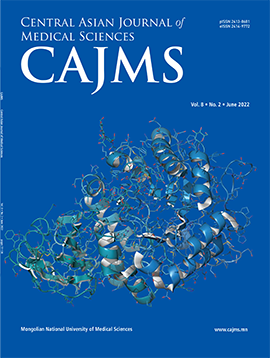ALBI Score for Predicting Acute Liver Failure in Patients with Acute Hepatitis B and D in Mongolia
DOI:
https://doi.org/10.24079/cajms.2021.03.008Keywords:
Acute Hepatitis B, Acute Hepatitis Delta, Acute Liver failureAbstract
Objectives: Mongolia is known as one of the countries with a high prevalence of hepatitis B and D virus infection. Although the number of acute hepatitis D cases is decreasing since the national vaccination program against HBV launched in 1991, it is still a main cause of acute liver failure (ALF) in Mongolia. The aim of this study is to determine the prognostic value of an ALBI score in patients with acute hepatitis B with or without D. Methods: A total of 114 patients (58 patients with acute hepatitis B (AHB), five patients with HBV/HDV co-infection, and 51 patients with HBV/HDV superinfection), who were admitted to the National Center for Communicable Diseases between 2017 and 2019 were enrolled into this study. Results: We compared the AHB group to the HBV/HDV superinfection group. The mean age was 25.8±6.5 years in the AHB group vs. 28.9±7.4 years in the HBV/HDV superinfection group (p = 0.019). Also, a majority of patients live in Ulaanbaatar (87.5% vs. 62.7%, p = 0.037). The mean hospitalization days was 23± 11 in the AHB, on the other hand it was 28± 13 in the HBV/HDV superinfection group (p = 0.022). The ALF patients had a higher ALBI score, total bilirubin, transaminase, and INR compared with the non-ALF group. The platelet count was significantly lower in the AHB and HBV/HDV infection group with ALF compared with AHB and HBV/HDV infection without ALF. This study showed that the ALBI score in AHB with ALF patients was significantly higher than in AHB without ALF (p = 0.001 ), and H BV/HDV superinfection with ALF had a higher ALBI score than HBV/HDV superinfection without ALF (p = 0.041 ). The area under the curve (AUC) value was 0.766 for ALBI scores. The cut-off value, sensitivity and specificity of ALBI score values were -1. 71, 72.2%, and 75.6%, respectively. Conclusions: ALBI score determined on admission indicates the likelihood of survival of patients with AHB and AHD.
23
Downloads
Published
How to Cite
Issue
Section
License
Copyright (c) 2021 Mongolian National University of Medical Sciences

This work is licensed under a Creative Commons Attribution-NonCommercial 4.0 International License.




